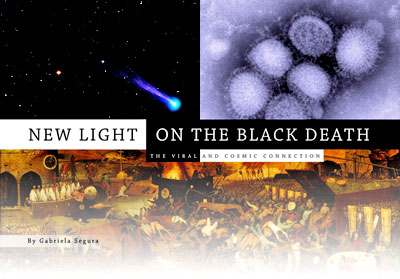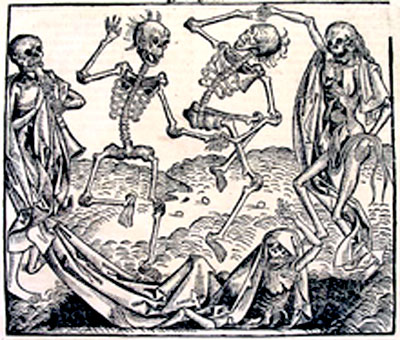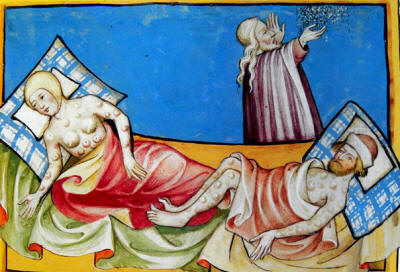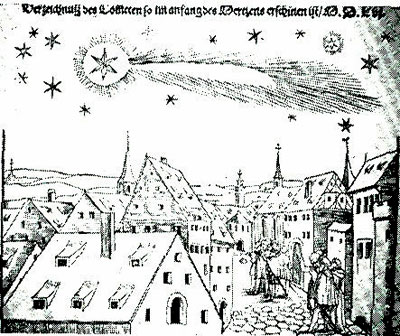|
by Gabriela Segura, M.D.
07 May 2011 from Sott Website
In 2007, a meteorite fell in Puno, Southeastern Perú.
José Macharé - scientist of the Geologic, Mining and Metallurgic Institute in Perú - said that the space rock fell near a muddy area by Lake Titicaca, making the water boil for around ten minutes, and mixing with the soil and emanating a gray cloud, the components of which remain unknown.
Having discarded radioactive poisons, this toxic cloud is said to have caused headaches and respiratory problems in at least 200 persons from a population of 1500 inhabitants.
Other than this event,
As a physician, I usually concentrate strictly on medical and health-related issues, not history or catastrophism.
However, like so many other people, I see signs of atmospheric changes on our planet which, according to many experts, may well be due to increasing comet dust loading.
When I read about increasing reports
of fireballs all around the world, and I know that these factors
must have an effect on the health of individuals and societies, it
motivates me to do the research to find the connections so that I am
better prepared for what may lie in our future. If our planet is
entering a new cometary bombardment cycle, and if these comets
harbor new species of microbes unknown to mankind's collective
immunological systems (as may well be the case), then being
forewarned is being forearmed.
Then as
Earth passes though the stream, the dust and viruses load our
atmosphere, where they can stay suspended for years until gravity
pulls them down. They compare numerous plagues throughout our
history which coincide with cometary bodies in our skies. These
researchers are certain that germs causing plagues and epidemics
come from space.
Could this explain why new strains of the influenza virus that are capable of engendering epidemics, and which are caused by radical genetic mutations, usually originate in Asia?
Wickramasinghe argues that if the virus is only minimally
infective, the subsequent course of its global progress will depend
on stratospheric transport and mixing, leading to a fallout
continuing seasonally over a few years; even if all reasonable
attempts are made to contain an infective spread, the appearance of
new foci almost anywhere is a possibility.
But in a study published in the journal Meteoritics and Planetary Science [2], it is detailed that amino acids - the building blocks of life - were found in a meteorite where none were expected.
Why? Because this particular meteorite formed when two asteroids collided, the shock of collision heating it to more than 2,000 degrees Fahrenheit - hot enough that all complex organic molecules like amino acids should have been destroyed.
They found them anyway, and their study cites the possibility of sample contamination being highly unlikely. In addition to amino acids, they found minerals that only form under high temperatures, indicating that they were indeed forged in a violent collision.
Jennifer Blank of SETI has done experiments with amino acids in
water and ice, showing they can survive pressures and temperatures
comparable to a low-angle comet-Earth impact or asteroid-asteroid
collision.
Joseph points out that medieval Europe and colonial America are areas where comets were observed to coincide with plagues and disease, adding that Comet Encke, the likely origin of the Tunguska impactor and the 1918 Flu epidemic, also coincide.
He writes:
Joseph argues that cometary debris, and the smaller particles and any microbes and viral particles attached to cometary debris impacting earth, fall upon the upper atmosphere and then slowly drift upon the air currents, sometimes staying aloft for years, crisscrossing the planet and gently falling downward, until finally making a soft landing on whatever is beneath them - be it ocean, river, animal, plant, or woman and man.
In fact, it is known that
microorganisms exist in significant concentrations in Earth's
atmosphere, and they have been found in air samples collected at
heights ranging from 41 km to 77 km. The natural mechanisms which
transport microorganisms into the atmosphere are storms, volcanoes,
monsoons, and cometary impact events.
These spheres were typical of extraterrestrial bodies having a composition very high in iridium, nickel, cobalt and other metals, and an unusually high content of these same metals were later found in Antarctic ice cores - but in the layer relating to the year 1912. [4]
That is to say, it took four years for these metals deposited in the stratosphere to precipitate onto Earth.
Was
the Tunguska object a source of new strains of virus never seen
before on Earth?
In fact, they are perfectly adapted to a life on some frozen astral object traveling through space.
Supporting this, it is known that Richard Hoover of NASA discovered microorganisms in deep ancient ice cores over 4,000 years old, drilled from Lake Vostok, near the South Pole.
These creatures were
found in association with ancient cosmic dust particles which had
fallen from space. Moreover, microbes recovered from Lake Vostok
increase in number with increasing numbers of dust particles (S.
Abyzov et al., Microbiologiya, 1998, 67: 547).[3]
This is the so-called
Panspermia
theory. [6]
Thomas Wood, professor in the Artie McFerrin Department of Chemical Engineering at Texas A&M University, explains how viruses replicate themselves by invading bacterial cells and integrating themselves into the chromosomes of the bacteria.
When this happens, a bacterium makes a copy of its chromosome, which includes the virus particle. The virus can then choose at a later time to replicate itself, killing the bacterium.
Having already
integrated itself into the bacterium's chromosome, the virus is
subject to mutation as well.
Its progress was very rapid in the early stages, from December 1347 to June 1348, when it spread through Italy and France, Spain and the Balkans. Crossing the Alps and Pyrenees, it eventually reached Sweden, Norway, and the Baltic by December 1350. Many villages were completely depopulated and disappeared, but the progression of the disease included zones of total avoidance as well.
The Black Death stayed in Europe for the next
three centuries,
disappearing finally in the seventeenth century in 1670 when it was
apparently at the peak of its power.
Inspired by Black Death, The Dance of Death is an allegory on the universality of death and a common painting motif in late medieval period.
A new and unique
virus formed under conditions facilitated by cosmic impacts could be
lethal to a population that is not previously immunized (here,
natural immunity is intended) against it. But as immunization is
acquired within a population, the course of the disease or the
disease itself can change.
This case is synthesized in the book
Return of the Black
Death [8], in which Susan Scott and Christopher Duncan from
Liverpool University carefully put all the available clues together,
tracking the plague from its first appearance out of nowhere and
chronicling its unprecedented catastrophic effects on European
civilization - death on a scale that is unimaginable, but could very
well happen again, at any time.
Not only that, they were also able to establish these vital statistics of the plague:
The authors were astonished when they were able to work out the duration of these statistics in more than 50 different plague outbreaks in England and to verify the length of the latent and infectious periods many times.
The correspondence with the universal 40-day "quarantine" period established as successful prophylaxis during the time of the plague supported their conclusions. From the data available in other countries, they argue convincingly that these statistics applied to the Black Death in all of Europe.
It was
evident that the key to the success of the plague in the Middle Ages
lay in its exceptionally long incubation period.
If this latent period is shorter than the incubation period, an infected person will be infectious before the symptoms appear and he or she may unknowingly transmit the disease to others.
Eventually, the disease runs its course in the body and
for the infection to persist, it must have infected at least one
other person.
Since nobody had been exposed to the disease before, almost everyone who made effective contact with an infectious person caught the disease and died, but there were reports of a few people who apparently had a natural protection against this new disease.
Illustration of the Black Death from the Toggenburg Bible (1411).
What about the bubonic plague?
Some rats are highly vulnerable and die, whereas
others are resistant and can survive an infection. This is a key
concept, since the disease will die out if all rats are highly
vulnerable, whereas it will persist in areas where there is a
balance between susceptible and resistant rats.
They argue that:
Right from the beginning, the people of medieval Europe
realized that it was an infectious disease spread directly from one
person to another, not a disease associated with, or coming from,
rats.
The infectious agent also appeared to have been remarkably stable; if there were mutations, these didn't change the course of the disease, at least not for 300 years. The plague was believed to have been passed by droplet infection; it was considered to be safe if one kept at least 4 meters (13 feet) away from an infected person out-of-doors.
Most interesting of all, there exists a strong genetic selection among European populations in favor of the CCR5-Δ32 mutation. This mutation results in the genetic deletion of a portion of the CCR5 gene which codes for a protein that is an entry port used by some viruses.
This mutation makes a homozygous carrier resistant to HIV-1
virus infections, and may have made them resistant to the Black
Death.
As with the Black Death, the epidemic in Athens
was localized geographically, it declined and disappeared as
abruptly as it had started, and no known current disease fits its
description by the historian Thucydides.
A scene showing monks, disfigured by the plague, being blessed by a priest. England, 1360–75.
What we do know is that a more virulent form of smallpox came to the fore in the 1630s and, just as the Black Death disappeared from the stage of history, smallpox took its place as the most feared of human diseases. We can only speculate.
Smallpox virus, as opposed to the causative agent of the Black death, is very resistant to cold temperatures, making it a more viable virus.
According to the data collected by Scott and
Duncan which describe the disease process of the Black Death,
hemorrhagic smallpox is almost virtually identical to the Black
Death.
Plague outbreaks often coincided against a background of food shortages, famines, flooding, peasant uprisings and religious wars. In certain countries, there were volcanic eruptions, earthquakes and famines. And not only did the plague outbreaks coincide with cometary impacts, but earthquakes themselves may well have been indications of cometary impacts.
Dendrochronologist Mike Baillie of Queen's University, Belfast,
Ireland makes this case in his book
New Light on the Black Death -
The Cosmic Connection. [10]
Baillie shows that the exact same signature is present at the time of the Black Death in both the tree rings and in the ice cores, but also at other times of so-called "plagues and pandemics".
Baillie points out that earthquakes could be caused by cometary explosions in the atmosphere or even by impacts on the surface of the earth. In fact, the ammonium signal in the ice-cores is directly connected to an earthquake that occurred on January 25th, 1348.
He correlates this
with accounts of the 14th century that the plague was "corruption of
the atmosphere" that came from this earthquake.
Comet of 1681.
What can we possibly do to counteract such infectious
threats? Could dietary changes influence the appearance and
disappearance of diseases?
Meat was more expensive and therefore more prestigious and, usually in the form of wild game, was common only on the tables of the nobility which, according to some of the accounts, was hardly affected by the Black Death.
So it
very well may be that meat consumption is a nutritional protection
against diseases of various kinds, including the Black Death (the
Paleolithic archaeological record certainly supports this idea).
The lectin of wheat is known to be pro-inflammatory, immunotoxic, neurotoxic, cytotoxic, cardiotoxic and may interfere with gene expression, disrupt endocrine function, may adversely affect gastrointestinal function and - surprise - lectins share pathogenic similarities with certain viruses.[11]
A population with bread as a staple food is unquestionably susceptible to disease and, ultimately, pandemic. As it was then, we are nowadays just as vulnerable due to the industrialization of our food supply.
Nutritionally deficient foods,
plus widespread cereal consumption, added to the overwhelming
toxicity of our environment (heavy metals, fluoride, toxic additives
in foods, etc), have prepared us as the perfect population for
destruction by the return of the Black Death.
|






